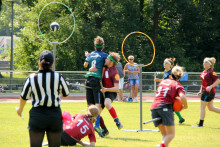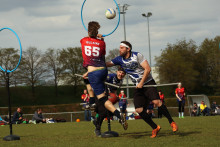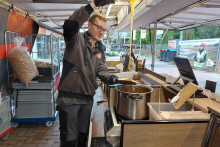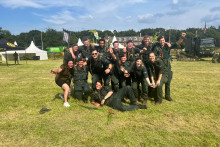The tournament started on Saturday, when six teams competed in the group play pools to secure their positions in the plays-ins and semi-final. Twentse Thestrals played very well, opening with a 110*-60 win against the Dom Tower Dementors from Utrecht [the * means that this team caught the snitch -red] and later outclassing Lumos Eindhoven with a 130*-0 win. This ensured their immediate placement in the semi-finals, skipping the play-ins altogether.
The next day, the UT team Twentse Thestrals faced the North Sea Nargles (Leiden/Amsterdam) in the semi-finals, and again dominated the pitch with a 110*-40 final score. Surprisingly, the Dom Tower Dementors defeated the Rotterdam Ravens, who were favourites for the finale, and as a result the Twentse Thestrals faced their competitor from the day before, who also happened to be the defending champions from last year’s Cup.
How does Quidditch work?
The Muggle version of Quidditch is played by two teams, each consisting of seven players: one keeper, three chasers, two beaters, and a seeker. The keeper and chasers only use the quaffle (a soft volleyball) to score and/or prevent goals. The beaters use so-called bludgers (dodgeballs) to disrupt the play of the other team. Last but not least there is the seeker, who plays an important role since he/she is the only one who may try to catch the snitch. The snitch is a neutral player, carrying a tennis ball in a sock on his back, who comes into play after 17 minutes of playing time and is joined by the two seekers exactly one minute later.
The game thus fixes several of the flaws of Quidditch from the Harry Potter books, most notably by guaranteeing at least 18 minutes of ‘quaffle play’, but also by offering a more logical scoring system. Here, one goal with the quaffle is worth 10 points and catching the snitch gives you 30 points, contrary to the 150 points from the books. Catching the snitch can still be decisive but is not the game-changer that it was in the books.
Before the final took off, we talked about the tactics of the Twentse Thestrals with Lars van den Broek (ICT at Saxion): ‘Our team has two players guarding the hoops, one keeper and one chaser. Some other teams use three defenders instead of two. There’s also a point chaser and a chaser who runs around the hoops to score from there after a long pass. The area behind the hoops is called the dungeon and this chaser is named the troll. So, there are a lot of tactics involved, and considerable differences between teams.’

The final
Even though the Twentse Thestrals were the favourite team to win the final – due to their victory the day before – it became clear after both teams did their group yell and the game took off, that this was not going to be an easy victory. The Dom Tower Dementors gave it their all and fought back from being 40-70 behind in score, to a 70-70 draw.
Around this point, the Snitch came into play, and one minute later the Seekers entered the pitch and started their hunt. In the meantime, tensions on the field rose, and the occasional yellow card was handed out. Eventually, the Dom Tower Dementors took the lead with a 90-80 score, and it started to look problematic for the Twentse Thestrals. However, at that point their seeker managed to catch the snitch, and after a brief discussion amongst the referees, they were awarded the victory, with a final score of 110*-90 for the Twentse Thestrals.








